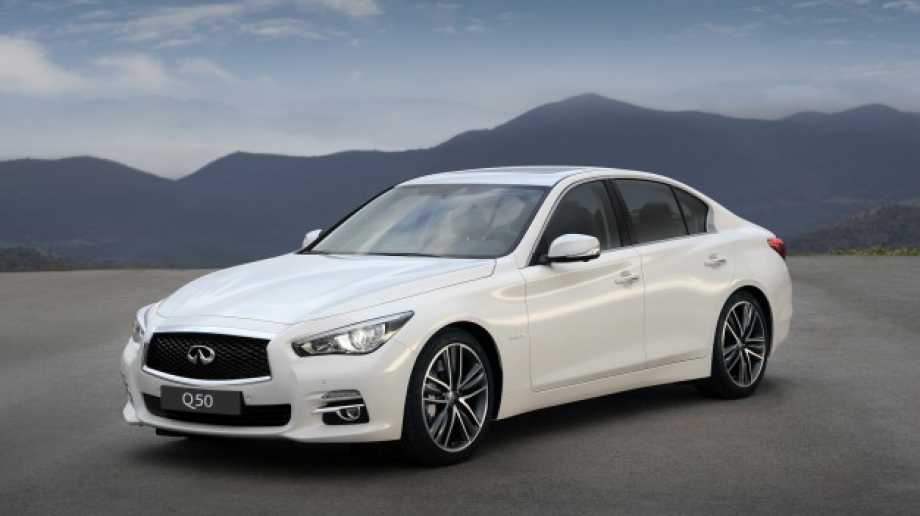Infiniti Q50

The Q50 looks sleek – not too sporty, not too conservative. But does it stand out enough to tempt fleet drivers out of their trusted German brands? Karl O’Sullivan does a fair few miles to see how efficient the Infiniti Q50 is in the real world
Introduced in Europe in 2008, Infiniti is Nissan’s luxury brand, probably best known for its association with the Red Bull Formula One team. Placed in the compact executive fleet sector where established cars such as the BMW 3 series and Audi A4 set the benchmark, the model on test is the 2.2d 7-speed Sport Automatic, priced at £35,630 inc a £660 option for metallic paint. The list of standard equipment is impressive and vast. Forgive me if I don’t mention every app and sensor.
Quality finish
The interior is well built with a quality finish, with heated front seats, rear ski hatch, electric sunroof and USB iPod connectivity. Considering how many features are available, I found it fairly intuitive. There’s a toggle to quickly shift between driving modes, which include an Eco mode which adds resistance to the accelerator and keeps the engine rpm down where possible, helping reduce the fuel flow. The Infiniti InTuition System allows up to four drivers to personalise their own settings for driving position, side mirrors, driving modes, climate settings, etc. linked to the drivers Intelligent Key.
A dual touchscreen infotainment system features the Infiniti InTouch Apps. The Q50 comes installed with a driving performance app which displays fuel flow, fuel consumption and cornering forces – all through digital gauges. You can take this further by syncing your smartphone and download other apps, such as Facebook and Google. A Bose audio system provides a surround sound for front and rear passengers.
Aviation technology
The Q50 uses technology developed in the aviation industry. Direct Adaptive Steering, or steer-by-wire as its more commonly known, means that there is no physical contact between the steering wheel and the car’s front wheels. Every turn of the steering wheel is transmitted to the wheels electronically, so if the wheels hit a pothole, the impact is not felt through the steering wheel, and you don’t have to make any sudden adjustments. This makes for a noticeably smoother and safer ride. The beauty of Direct Adaptive Steering is that it can be customised to suit your own driving style.
Performance
The Q50 is nearly 250kgs heavier than the BMW 320d, but I found that this weight can be used to help push the car along carrying more momentum, thus saving fuel, and the low, sleek, aerodynamic shape helps this further. I could lift off the accelerator much earlier than usual prior to roundabouts, traffic lights and especially downhill. Infiniti’s engineers worked on over a thousand types of shapes in a full-scale wind tunnel resulting in the Q50 having a coefficient of drag as low as 0.26 (the average car is between 0.30 - 0.35, BMW 3 series is 0.29).
The 2.1 diesel engine, which produces 295lb ft/400Nm of torque compared to 280lb ft/380Nm for the BMW 320d, is supplied by Mercedes-Benz and delivers CO2 emissions of 124g/km. On a 30‑mile commute on B‑roads and motorways, I managed over 55mpg. On a 170-mile journey, mostly on motorways, I achieved an impressive 58.1mpg. However, the Q50 wasn’t quite as efficient in urban areas as I struggled to get above 40mpg at low speeds in traffic, even using the stop-start technology. This should be expected with a car that weights in at 1,750kgs, and with a huge 74-litre fuel tank, at 58mpg this car could travel over 945 miles between fuel stops.
Safety features
The Q50 comes with an array of safety features including Active Lane Control, which uses cameras to sense if you move out of your lane without indicating. An audible warning is given, and if you continue to drift, the system will apply opposite side brakes to guide you back towards the centre of your lane. On a long trip back from Bristol I found this worked very well on motorways, but not as consistent on A and B roads where the road markings were not as visible.
The Blind Spot Intervention system uses sensors to detect if a vehicle is entering your blind spot area, initially with a warning light (perfectly placed in my peripheral vision, next to the side mirrors) followed by an audible warning sound and a graphical warning on the dash. It wasn’t just on the motorways where this feature was useful. In the city centre, detecting cyclists moving past, this technology could save collisions and even lives.
The Q50 also features a Predictive Forward Collision Warning using the front sensors to scan as far as two cars ahead. Whilst reversing, or when the cars sensors detect an object within close proximity, four camera’s provide a 360° birds-eye view. This is displayed on the dual screens ensuring parking and manoeuvring is a doddle. It didn’t take long before I was parking in tight spaces I never though possible in this 4.78m‑long saloon.
Competitively priced
The Q50 is efficient where it needs to be, covering medium to long distances rather than short commutes.
It’s well-built, competitively priced and with attractive looks that will appeal to fleet drivers looking for something that stands out in the car park. If you like your gadgets, look no further. The standard technology on board this car will trump any of its rivals.
But as a fairly new brand entering this sector, the Q50 has to do more than just stand out from the crowd if they want to seriously take on the established German brands.









